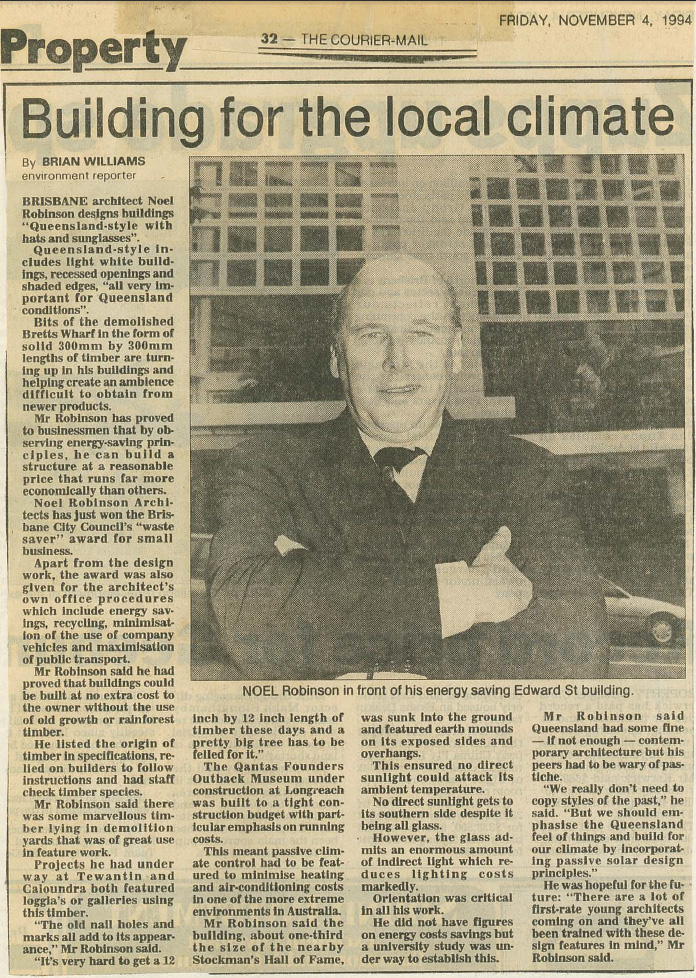Queensland-style with hats and sunglasses
Throwback Thursday: In an interview with the Courier Mail on 4 November 1994, Noel Robinson discussed using re-purposed building materials and building for the Queensland Climate, Queensland style with hats and sunglasses.

The text reads:
Brisbane architect Noel Robinson designs buildings “Queensland-style with hats and sunglasses”. Queensland-style includes light white buildings, recessed openings and shaded edges,
all very important for Queensland conditions”.
Bits of the demolished Bretts Wharf in the form of solid 300mm by 300mm lengths of timber are turning up in his buildings and helping create an ambiance difficult to obtain from newer products. Mr Robinson has proved to businessmen that by observing energy-saving principles, he can build a structure at a reasonable price that runs far more economically than others.
Noel Robinson Architects has must won the Brisbane City Council’s “waste saver awards for small business. Apart from the design work, the award was also given for the architect’s own office procedures which include energy savings, recycling, minimisation of the use of company vehicles and maximisation of public transport.
Mr Robinson said he had proved that buildings could be built at no extra cost to the owner without the use of old growth or rainforest timber.
He listed the origin of timber in specifications, relied on builders to follow instructions and had staff check timber species.
Mr Robinson said there was some marvellous timber lying in demolition yards that was of great use in feature work.
Projects he had underway at Tewantin and Caloundra both featured loggia’s or galleries using this timber.
“The old nail holes and marks all add to its appearance,” Mr Robinson said.
“It’s very hard to get a 12 inch by 12 inch length of timber these days and a pretty big tree has to be felled for it”.
The Qantas Founders Outback Museum under construction at Longreach was built to a tight construction budget with particular emphasis on running costs. This meant passive climate control hd to be featured to minimise heating and air-conditioning costs in one of the more extreme environments in Australia.
Mr Robinson said the building, a bout one-third of the size of the nearby Stockman’s Hall of Fame was sunk into the ground and featured earth mounds on its exposed sides and overhangs. This ensured no direct sunlight could attack its ambient temperature. No direct sunlight gets to its southern side despite it being all glass. However the glass admits an enormous amount of indirect light which reduces lighting costs markedly.
Orientation was critical in all his work. He did not have figures on energy costs savings but a university study was under way to establish this.
Mr Robinson said Queensland had some fine-if not enough- contemporary architecture, but his peers had to be wary of pastiche. “We really don’t need to copy styles of the past”, he said. “But we should emphasise the feel of things and build for our climate by incorporating passive solar design principles”.
He was hopeful for the future: “There are a lot of first-rate young architects coming on and they’ve all been trained with these design features in mind. ” Mr Robinson said.
